Made it to the last assignment, essay completed and looking to curate a series of pictures and various mediums to show this. The initial title was “Depicting your environment” which didn’t grab me. In the last course, during this one I’ve found that a subject has to really interest me in order to have a proper go at it. This course in particular has taught me the importance of narrative and meaning however deep. Why would I want to depict something that in all honesty I want to escape and at the least detach myself from?
I read further in the coursework material that I could “curate” images, tell a story and even use an alter-ego to present these. I’m thinking I have and in…
The above five images are paintings (All oil colour, 20 x 30″ on canvas boards) I produced for my final assignment – in my last course – The Practice of Painting. The theme was formed and a response to a visit to the Somme battlefields. The series was named “The Language of Ghosts” and explored not just looking back, but the artists researched and their influence on me as well as the experience.
I’ve felt since that the above works were never fully realised and my experience wasn’t committed to art. We are in the midst of the centenary of World War One and wanted to explore this further but with a slightly different angle, possibly a more personal one? I’m not sure the assignment brief would allow this but I think the idea ticks most of the boxes.
The idea of an artistic soldier is not an new one, most of my own painting heroes were. I have recently read War and Turpentine by Stefan Hertmans – a well written account of his grandfathers account of the First World War and life experiences. The Guardians review link is below.
https://www.theguardian.com/books/2016/jul/02/war-and-turpentine-by-stefan-hertmans-review
This book and its effect on me is the premise for my collection of works for this assignment. I guess you’d have to read the book to fully understand the story, but hope that this series will capture some of it and add context of what I’m trying to say?
My role as blogger now becomes fictional narrator of a side story linked to Hertman’s true story of his late grandfather Urbain Martien (1891-1981).
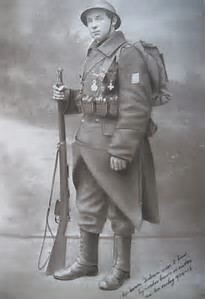
Urbain Martien
The story starts in Windermere, the Lake District and not Ghent in Belgium. I was approached by a descendant of Mrs Lamb, a nurse who looked after Martien, to put together / curate a series of artworks for a centenary exhibition. The works produced by him were during his convalescence in Windermere during World War One. These works were left to her as a thank you before he went back to the front in Belgium…
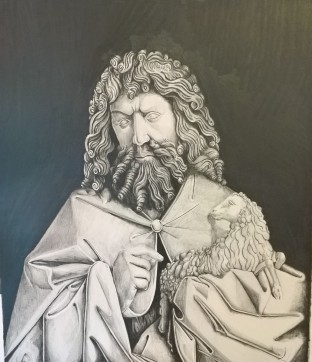
John The Baptist, After van Eyck – Graphite on Paper, A3
The drawing above is taken where Urbain started as a gifted artist before the war in his home city of Ghent, Belgium. It’s John the Baptist, a detail from The Ghent Altarpiece of which he was very familiar with. The van Eyck brothers and the Northern Renaissance has held a fascination for me, and one day will get to see the real thing so it seemed fitting to start with this work (It took over 20 hours work so its going in!)
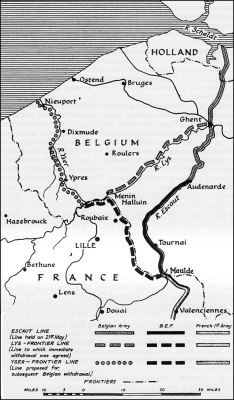
The above image, I hope gives a sense of place of where Urbain Martien served and adds context leading into the next set of drawings given to Mrs. Lamb – never did find out her first name…
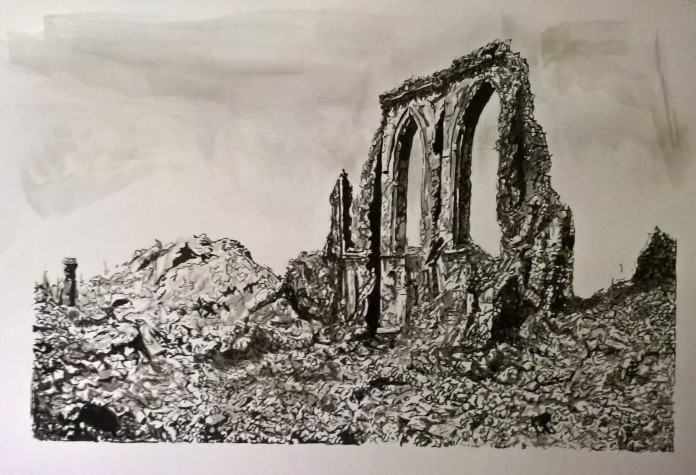
Demolished Church at Dixmude. Black Ink and Wash drawing on paper, A3
The above drawing is of a demolished church in Dixmude. This had special resonance for Martien, as it was a church he had visited as a child, but also his father who was a painter and restorer himself, worked here. Now all that remained was rubble and memory.
From this Mrs. Lamb presented me with some further ink drawings, in sepia ink this time – these seemed to me more “action shots”- quick, fluid gestural mark making and with more meaning in truth and add some substance as soldiers are in it too. The three drawings below are of a gas mask issued to Martien, Two soldiers on duckboards after the deliberate flooding of the polders using the River Yser and two soldiers reading a map in the trench where Martien was stationed.
The war was now becoming very real, the next sketch was of a friend injured from a snipers bullet. Theo took a shot in the face, lost sight in that eye and never recovered even though he survived the war – “are we the lucky ones?”
This is a heartfelt sketch, the face is well rendered and very human.
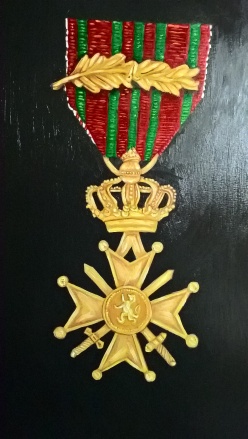
The above image is one of three decorations awarded to Urbain Martien. This one is the Belgian “Croix de Guerre” received for bravery…
The final image of the series is one of the most recognisable flowers and symbols of World War One – the Common Poppy, also Belgium’s national flower. Painted in the delicacy of watercolour, shows the beauty and fragility of nature

Papaver Rheas – Watercolour on Paper, A3
I found producing this series interesting in that it’s satisfying an itch and interest that is producing art borne out of war and conflict. Not to glorify it, but create my own lens of understanding the past. The creative arts, not just painting but photography, film, poetry and sculpture act as a language to memory in its own right.
All the pictures above, are from found images in keeping with the course as a whole. For mediums, I chose the ones I was most comfortable with, fitting with subject matter and the ones I think I have made the most progress throughout the course. Graphite, Watercolour, Ink and Oil Colour. Some pictures are looser in style and others highly detailed and trying to portray the mood, subject matter and the skills I have gained.
For artists that have influenced me regarding this assignment are possibly obvious? Jan van Eyck ( The Ghent Altarpiece), Goya ( Disasters of War – the wounded soldier particularly), Muirhead Bone, Deanna Petherbridge (Dixmude Church) and Maria Sybilla Merian( Poppy)
I’m relatively happy with this, and the subject for me will be one I will pursue much further… Over to the tutor now….
Bibliography
Jay Winter (2017) War beyond Words, Cambridge: Cambridge University Press.
Stefan Hertmans (2017) War and Turpentine: A Novel, London: Random House.
PAUL VAN PUL (2006) IN FLANDERS FLOODED FIELDS: BEFORE YPRES THERE WAS YSER., Barnsley: Pen & Sword Books Ltd











This is a lovely collection of work! It really works. Congratulations.
LikeLike